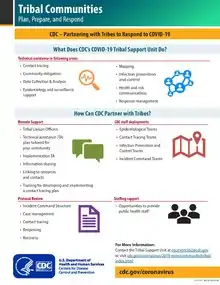Impact of the COVID-19 pandemic on Native American tribes and tribal communities
The impact of the COVID-19 pandemic on Native American tribes and tribal communities has been severe and has emphasized underlying inequalities in Native American communities compared to the majority of the American population.[1][2] The pandemic exacerbated existing healthcare and other economic and social disparities between Native Americans and other racial and ethnic groups in the United States. Along with Black Americans, Latinos, and Pacific Islanders, the death rate in Native Americans due to COVID-19 was twice that of white and Asian Americans,[3] with Native Americans having the highest mortality rate of all racial and ethnic groups nationwide.[3] As of January 5, 2021, the mortality impact in Native American populations from COVID-19 was 1 in 595 or 168.4 deaths in 100,000, compared to 1 in 1,030 for white Americans and 1 in 1,670 for Asian Americans.[3] Prior to the pandemic, Native Americans were already at a higher risk for infectious disease and mortality than any other group in the United States.[4]

Communities
Pre-pandemic conditions
Many Native Americans live in crowded conditions and with multiple generations in a single household, creating difficulties for social distancing and isolation within households. In addition to crowded living situations, many Native Americans live on tribal reservations which generally have substandard housing or face inadequate housing when living off-reservations. Other issues facing Native Americans include limited access to water, food insecurity, lack of phone service, and children relying on schools to provide breakfast and lunch[5][6][7]
Government and private sector response
Tribal response
In 2020, the National Indian Health Board created a COVID-19 Tribal Resource Center to provide information to Native Americans, much of which was created by Native Americans.[8] Information and resources on this site include videos, government reports, and websites created by Tohono O'odham Nation, the Hopi Tribe, Navajo Nation (including materials in the Navajo language), Pascua Yaqui Tribe, the American Indian Health Commission of Washington State, and tribes and tribal communities in New Mexico.
Many tribes and tribal communities provided COVID-19 statistics, preventative information, and healthcare and economic resources on their websites, including the following:
- Cherokee Nation[9]
- Choctaw Nation[10][11]
- Hopi Tribe[12]
- Muscogee (Creek) Nation[13]
- Navajo Nation[14]
- Pascua Yaqui Tribe[15]
- Tohono O'odham Nation[16]
Government response
In August 2020, the Centers for Disease Control and Prevention (CDC) provided $200 million in COVID-19 funding to Indian Country "to support tribes and tribal organizations in carrying out COVID-19 preparedness and response activities, including surveillance, epidemiology, laboratory capacity, infection control, and mitigation".[17] The CDC, National Indian Health Board, and the Indian Health Service created websites and infographics to provide information specifically for Native American tribes and tribal communities.[18]
Private sector response
In addition to government agencies, the Johns Hopkins Bloomberg School of Public Health's Center for American Indian Health also created resources to provide information on COVID-19 to Native American tribes and tribal communities.[19] These include social media kits, radio scripts, and fact sheets on social distancing, vaccine safety, and testing.
References
- McPhillips, Deidre (October 7, 2020). "COVID-19's Tragic Effect on American Indians: A State-by-State Analysis". U.S. News & World Report. Retrieved February 2, 2021.
- "COVID-19 and Indigenous peoples | United Nations For Indigenous Peoples". www.un.org. Retrieved 2021-02-02.
- "Color of Coronavirus: COVID-19 deaths analyzed by race and ethnicity". APM Research Lab. Retrieved 2021-02-01.
- "Programs | Center for American Indian Health". caih.jhu.edu. Retrieved 2021-02-01.
- "Programs | Center for American Indian Health". caih.jhu.edu. Retrieved 2021-02-01.
- "Native American Living Conditions on Reservations - Native American Aid". www.nativepartnership.org. Retrieved 2021-02-01.
- National Congress of American Indians (February 1, 2021). "Housing & Infrastructure". National Congress of American Indians. Retrieved February 1, 2021.
- "COVID-19 Community Health Tools - National Indian Health Board". NIHB. Retrieved 2021-02-01.
- "Cherokee Nation Health Services". Cherokee Nation Health Services. Retrieved 2021-02-01.
- "Chahta Achvffa Member Portal | Choctaw Nation". www.choctawnation.com. Retrieved 2021-02-01.
- "COVID-19 | Choctaw Nation". www.choctawnation.com. Retrieved 2021-02-01.
- "Welcome to the Hopi Tribe". The Hopi Tribe. Retrieved 2021-02-01.
- "COVID-19 Response". Muscogee Creek Nation Department of Health. Retrieved 2021-02-01.
- "COVID-19". www.ndoh.navajo-nsn.gov. Retrieved 2021-02-01.
- "Pascua Yaqui Tribe". covid19.pascuayaqui-nsn.gov. Retrieved 2021-02-01.
- "Coronavirus". TON-HC. Retrieved 2021-02-01.
- "Coronavirus Disease 2019". Centers for Disease Control and Prevention. 2020-08-19. Retrieved 2021-02-01.
- Centers for Disease Control and Prevention (August 1, 2020). "COVID-19 Resources for Tribes". Centers for Disease Control and Prevention. Retrieved February 1, 2021.
- "Resource Library | Center for American Indian Health". caih.jhu.edu. Retrieved 2021-02-01.